 |
 |
 |
 |
 |
 |
 |
 |
 |
 |
 |
 |
 |
 |
 |
 |
 |
 |
 |
 |
 |
 |
 |
 |
 |
 |
 |
 |
 |
 |
 |
 |
 |
 |
 |
 |
 |
|
|
S� Velha de Coimbra |
|
|
|
 |
|
|
|
The Old Cathedral (S� Velha) of Coimbra is the only Romanesque cathedral in Portugal to have survived in its original form. The present building substituted an earlier one which had been built after the reconquest of the city in 1064. Contruction on the romanesque cathedral began in 1163, when Coimbra was the capital of the kingdom, and King Afonso Henriques spent as much money as he could to see it completed, and it was finished by the begining of 13th century. It seems that many of the artists working on the decoration of the cathedral were Christians from Muslim-dominated regions who had immigrated to Coimbra (mo�arabes). These artists were heavily influenced by moorish art, possibly explaining the style of the sculpted decoration of the cathedral. In particular, it might explain the total absence of human figures in the more that 300 capitals on the columns found throughout the church, which nevertheless masterly depict vegetal, animal or phantastic (griphs, centaurs) motifs, but no humans. Christian programatic compositions (Last Judgement, Last Supper, the Passion etc) are also absent. |
|
|
|
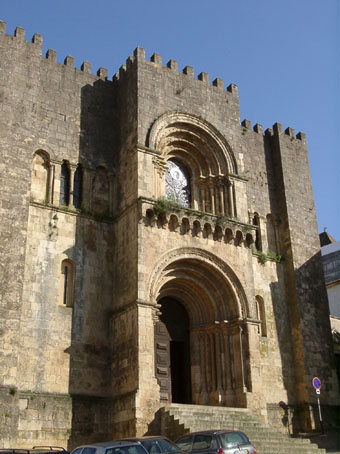 |
|
|
|
Left - Main facade of the Old Cathedral of Coimbra. The church has a Roman cross shape with three aisles, transept, a lantern tower over the crossing and three East chapels. The external appearance of the cathedral is one of a fortress, due to its compact, cubic shape and the crenelation over the walls. Its aggressive appearance is explained by the context in which the cathedral was built: the 12th century was one of constant wars against Muslim Arabs and Castilians, and the cathedral, as one of the biggest buildings of the city, was also planned to act as a defensive castle in case of a siege. The exterior of the cathedral has changed little, except for an early Renaissance North portal (Porta Especiosa) built in the 1530's by Jo�o de Ru�o. |
|
|
|
|
|
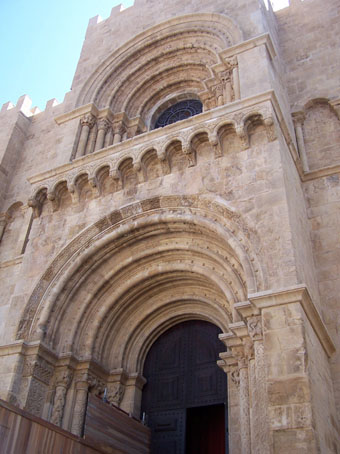 |
|
|
|
|
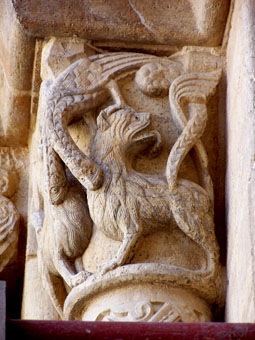 |
|
|
|
|
|
|
Up - The main fa�ade of the cathedral (right image) has two openings - the main portal and an upper window - which are similarly organised in concentric, round-shaped arches with columns. A decorated parapet over the main portal separates it from the window above. The portal columns (jambs) and some capitals have beautiful romanesque motifs.The photo on the left shows one capital with lions being attacked by a phantastic creature, half serpent, half bird, a probable representation of the evil of the world. |
|
|
|
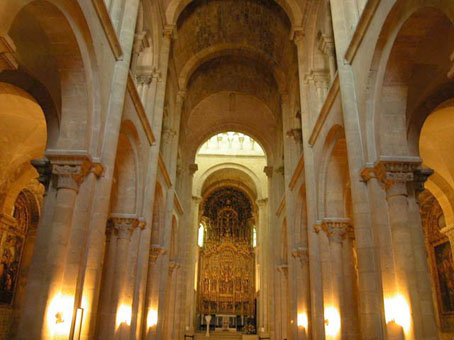 |
|
|
|
Left - Interior of the Old Cathedral of Coimbra viewed towards the main chapel. The nave has three aisles covered by barrel vaulting. The second floor of the central aisle has an elegant arched gallery (triphorium). Light comes in through the window of the main fa�ade and the windows of the lantern tower over the crossing. The South lateral chapel was rebuilt in the 16th century in Renaissance style and is the only non-Romanesque architectural element inside. |
|
|
|
|
|
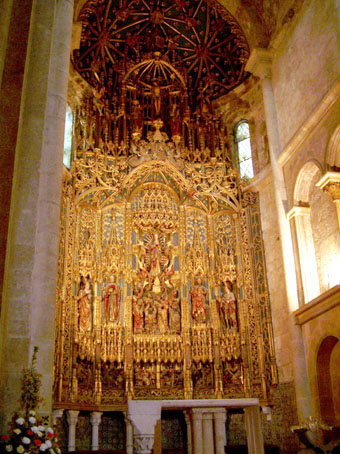 |
|
|
|
|
Right - In 1498, Coimbra's Archbishop commissioned an altar dedicated to the Holy Mary to Flemish masters Olivier de Gand and Jean de Ypres. The guilded altar occupies the whole apse of the old Romanesque choir and is the best example of sculpted wooden altar in Portugal in the Late Gothic style. The middle of the altar shows Mary being carried to Heaven by a group of Angels, sided by figures of the Apostles.The crucified Christ and a canopy of stars occupy the upper part of the altar.
Other notable features in the interior of the cathedral include a magnificent Renaissance altar dedicated to Jesus and the Apostles by French sculptor Nicolau de Chanterene; a beautiful Manueline baptismal font; late 15th century tiles on some walls and several Gothic tombs. |
|
|
|
|
|
|
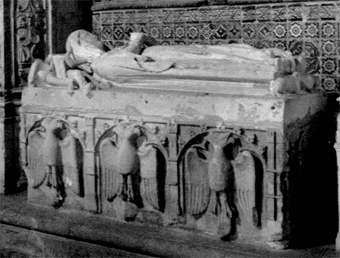 |
|
|
|
Left - Of the tombs in the nave, the one of D. Vata�a, who died around 1336, is particularly interesting. She was a Byzantine princess that was an atendant to D. Isabel of Aragon, the princess that had come to Portugal to marry King Dinis I in 1282. Her tomb is the best Gothic tomb in the Cathedral and features a coat-of-arms totally alien to Portugal: the double-headed eagle of the Byzantine Empire. The tomb is attributed to Master Pero (Mestre Pero), an Aragonese sculptor who had also come to Portugal with D. Isabel. |
|
|
|
|
|
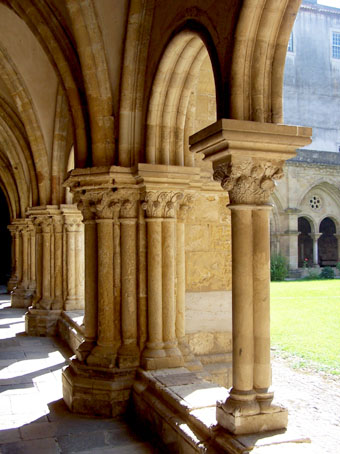 |
|
|
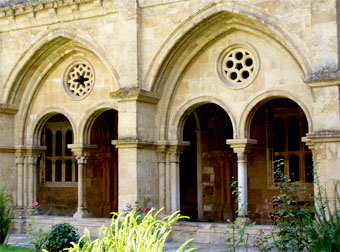 |
|
|
|
|
|
|
Up - Views of the cloisters of the Old Cathedral. Construction on the cloisters began around 1218, and may have continued until around 1240. It is one of the oldest in the country and shows intermediate features between Romanesque and Gothic. The arches that connect the galleries with the courtyard are composed of two types of arches: an outer, slightly pointed arch (typical of early Gothic) and two smaller, round arches (typically Romanesque). The pediments of these arches have openings with primitive tracery, each of them unique. The galleries are roofed with quatripartite, ribbed groin vaulting. |
|
|
|
 |
|
|
|
Romanesque
Index |
|







